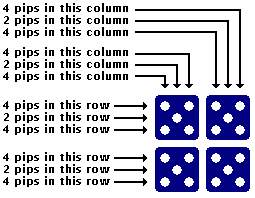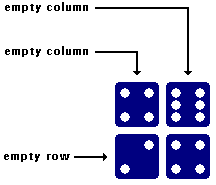
|
|
| |||

| Players: | 2 or more | |||||||||||||
| Average Duration: |
| |||||||||||||
| Equipment: | one set of 4 dice per player, each set distinguishable from the others, and another unique set of as many dice as there are players (see below for more details) | |||||||||||||
| Object: | To be the first player to reach 21 points by overcoming challenges determined by dice rolls. |
|
|
The game is played with several dice. Ideally, each player will have four colored dice and one white die; the non-white dice should be different colors for each player. For example, one player might have four red dice and one white die, and another might have four green dice and one white die, and another might have four blue dice and one white die.
If dice are a limited commodity, it will suffice to have just nine total dice: a set of four like dice, a second set of four like dice, and one white die. These dice can be shared according to the game's needs at various stages. And, of course, it is not strictly necessary that the one white die per player actually be white, although for the purposes of simplicity, these directions will hereafter refer to these dice as the white dice. The other dice will be referred to as the colored dice.
To see who goes first, each player rolls all five of his dice. The player with the highest white die goes first. In the event of a tie, the sum of the four colored dice is used as a tie breaker.
On a player's turn, he rolls all five of his dice. If the white die is a one, his turn ends immediately if he is in the lead or tied for the lead. If he is neither in the lead nor tied for it, he ignores this roll and rolls all five dice again.
If the white die is anything but a one, it specifies a particular challenge to be played with the other four dice. Upon successful completion of the challenge, the player will score a certain number of points, and then play will pass to the player on his left. The game ends when someone reaches 21 or more points.
A description of each challenge follows.
Challenge: | 2 | |
| Common Scores: | 1-3 | |
| Maximum Score: | 5 |
If the white die is a two, a Poker-like game is played with the remaining four dice. The player may choose to let the four colored dice stand, or may take up to two rerolls, each time rerolling any or all of the four dice. The score for the round is determined by the following chart:
| one pair (e.g., two fives) | 1 point | |
| two pairs (e.g., two fives and two sixes) | 3 points | |
| one triple (e.g., three fives) | 3 points | |
| one quadruple (e.g., four fives) | 5 points | |
| a run of three (e.g., two, three four) | 2 points | |
| a run of four (e.g., two, three, four, five) | 3 points |
Challenge: | 3 | |
| Common Scores: | 1-3 | |
| Maximum Score: | 12 |
If the white die is a three, a game similar to Tic-Tac-Toe is played against the player's opponent (or, if there are more than two people playing, the player may choose which of his opponents to play against). The opponent rolls all four of his colored dice.
The player makes the first move with his white three; this is placed in the middle square of an imaginary 3x3 grid. Then the player and his opponent, starting with the opponent, take turns placing their four colored dice in this grid. After all nine dice are placed, the original player scores one point for each three-in-a-row pattern (across, down, or diagonally) he has managed to form with his dice (the central white die counts as his own), plus one point for each 2x2 square (for example, the upper-left, upper-middle, middle-left, and center dice count as a 2x2 square) containing only his dice. Note that only the original player scores; the opponent never scores anything -- his goal is merely to block the original player from scoring.
There are rules, however, about who can play what dice where. The original player may only place a die next to one (not diagonally) already on the board, and he may only do so if the number on the die is one less, one more, or equal to the adjacent die already on the board. Note that the six wraps back around to the one, so a one is legal to play next to a six and vice versa.
If an empty square is adjacent to more than one die, only one adjacent die (any one of them) need be taken into consideration. For example, if an empty square is adjacent to both a two and a four, then a one, two, three, four, or five, but not a six, are legal to play in the empty square.
The opponent has slightly stricter constraints on what he can play. Like the original player, he may only place a die adjacent to one already on the board. But he can only play a die that is one number higher or lower than the adjacent die (again, wrapping around from six to one if necessary). He cannot play a die that is the same number as the adjacent die. Like the original player, if an empty square is adjacent to more than one die, only one adjacent die need be taken into consideration.
During a player's turn, he must make a legal play if he has one. If he does not (either because none of his dice can be played legally, or because he has no dice left at all), he passes. If neither player can play and the original player has used up all of his dice, then he can claim the remaining empty squares on the board for his own. If neither player can play but the original player still has dice left, the opponent claims the remaining empty squares.
Challenge: | 4 | |
| Common Scores: | 2-4 | |
| Maximum Score: | 5 |
If the white die is a four, the challenge is to match dice with the player's opponent (or, if there are more than two people playing, the player may choose which of his opponents to play against). The opponent rolls all four of his colored dice.
The original player scores one point for each "match" he can make by matching up his own dice with his opponent's dice. A match can be made by pairing up one die of his own with an equal die of his opponent's. A match can also be made by matching a die of his own with two or more of his opponent's dice that add up to the same number (for example, the player's own 4 can match with his opponent's 1 and 3). Conversely, a match can be made by matching one of his opponent's dice with two or more of his own that add up to that number. It's also legal to match multiple dice to multiple dice (for example, the player's own 4 and 5 can be matched with his opponent's 3 and 6).
Each die can only participate in one match. Each match counts one point. If the player uses all four of his dice in matches (whether or not all four of his opponent's dice are used in the matches), he scores an extra point.
But it's not as simple as that. After the opponent has rolled all four of his dice, the original player must choose two of his own dice to reroll. After they are rerolled, his opponent must choose two of his own dice to reroll. After that, the original player may reroll just one of his dice. Whether he does or doesn't, at that point he must form and score whatever matches he can.
Challenge: | 5 | |
| Common Scores: | 2-3 | |
| Maximum Score: | 8 |
If the white die is a five, the other four dice must be arranged into a 2x2 square, and points are awarded based on the arrangement of the pips on the dice. As in other challenges, the player may let the four colored dice stand, or may take up to two rerolls, each time rerolling any or all of the four dice.
The player may arrange the dice into a 2x2 square in any way, turning dice around and swapping them with others, so long as he does not change what number is facing upward (the two rerolls are the only way he may do that).
When four dice are arranged in a 2x2 square, one can imagine six rows and six columns of possible pips, three rows and three columns on each die. For example, if four fives are arranged in a 2x2 square, there will be four pips in the first, third, fourth, and sixth rows, and two in the second and fifth rows. Similarly, there will be four pips in the first, third, fourth, and sixth columns, and two in the second and fifth columns. This is illustrated in the following diagram:

The object is to get rows and columns with no pips at all. The score for the round is the number of empty rows and columns. The four fives in the diagram above, therefore, score zero points, because there are no empty rows or columns. The following example, however, scores three points: one each for the two empty columns, plus one for the empty row.

Challenge: | 6 | |
| Common Scores: | 1-3 | |
| Maximum Score: | 6 |
If the white die is a six, the player scores points by making sixes with the remaining four dice. As in most of the other challenges, the player may let the four colored dice stand, or may take up to two rerolls, each time rerolling any or all of the four dice.
The player scores one point for each set of one or more dice (not counting the white die) that add up to six. For example, a single six counts as a point, as does a pair of threes. Dice can be used in more than one set: for example, a two and a pair of fours count two points, because the two can be matched up with both fours. Four threes count six points, one for each distinct pair of threes.